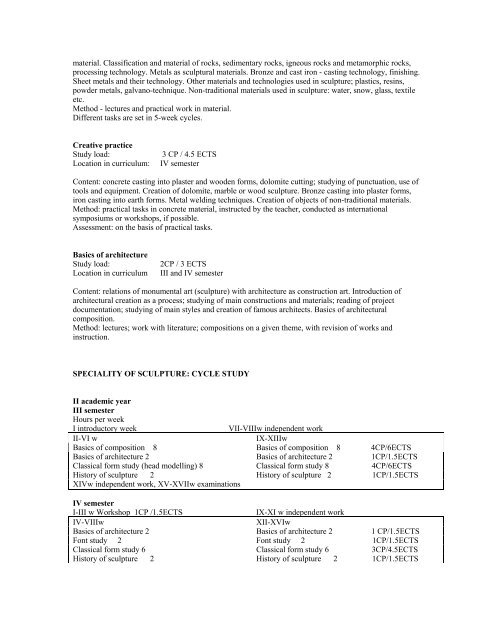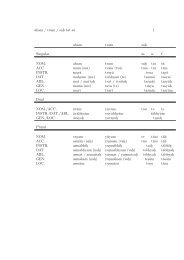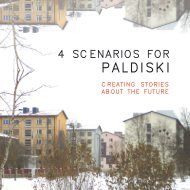Fine Art - Eesti Kunstiakadeemia / Estonian Academy of Arts
Fine Art - Eesti Kunstiakadeemia / Estonian Academy of Arts
Fine Art - Eesti Kunstiakadeemia / Estonian Academy of Arts
You also want an ePaper? Increase the reach of your titles
YUMPU automatically turns print PDFs into web optimized ePapers that Google loves.
material. Classification and material <strong>of</strong> rocks, sedimentary rocks, igneous rocks and metamorphic rocks,<br />
processing technology. Metals as sculptural materials. Bronze and cast iron - casting technology, finishing.<br />
Sheet metals and their technology. Other materials and technologies used in sculpture; plastics, resins,<br />
powder metals, galvano-technique. Non-traditional materials used in sculpture: water, snow, glass, textile<br />
etc.<br />
Method - lectures and practical work in material.<br />
Different tasks are set in 5-week cycles.<br />
Creative practice<br />
Study load: 3 CP / 4.5 ECTS<br />
Location in curriculum: IV semester<br />
Content: concrete casting into plaster and wooden forms, dolomite cutting; studying <strong>of</strong> punctuation, use <strong>of</strong><br />
tools and equipment. Creation <strong>of</strong> dolomite, marble or wood sculpture. Bronze casting into plaster forms,<br />
iron casting into earth forms. Metal welding techniques. Creation <strong>of</strong> objects <strong>of</strong> non-traditional materials.<br />
Method: practical tasks in concrete material, instructed by the teacher, conducted as international<br />
symposiums or workshops, if possible.<br />
Assessment: on the basis <strong>of</strong> practical tasks.<br />
Basics <strong>of</strong> architecture<br />
Study load: 2CP / 3 ECTS<br />
Location in curriculum III and IV semester<br />
Content: relations <strong>of</strong> monumental art (sculpture) with architecture as construction art. Introduction <strong>of</strong><br />
architectural creation as a process; studying <strong>of</strong> main constructions and materials; reading <strong>of</strong> project<br />
documentation; studying <strong>of</strong> main styles and creation <strong>of</strong> famous architects. Basics <strong>of</strong> architectural<br />
composition.<br />
Method: lectures; work with literature; compositions on a given theme, with revision <strong>of</strong> works and<br />
instruction.<br />
SPECIALITY OF SCULPTURE: CYCLE STUDY<br />
II academic year<br />
III semester<br />
Hours per week<br />
I introductory week VII-VIIIw independent work<br />
II-VI w IX-XIIIw<br />
Basics <strong>of</strong> composition 8 Basics <strong>of</strong> composition 8 4CP/6ECTS<br />
Basics <strong>of</strong> architecture 2 Basics <strong>of</strong> architecture 2 1CP/1.5ECTS<br />
Classical form study (head modelling) 8 Classical form study 8 4CP/6ECTS<br />
History <strong>of</strong> sculpture 2 History <strong>of</strong> sculpture 2 1CP/1.5ECTS<br />
XIVw independent work, XV-XVIIw examinations<br />
IV semester<br />
I-III w Workshop 1CP /1.5ECTS IX-XI w independent work<br />
IV-VIIIw XII-XVIw<br />
Basics <strong>of</strong> architecture 2 Basics <strong>of</strong> architecture 2 1 CP/1.5ECTS<br />
Font study 2 Font study 2 1CP/1.5ECTS<br />
Classical form study 6 Classical form study 6 3CP/4.5ECTS<br />
History <strong>of</strong> sculpture 2 History <strong>of</strong> sculpture 2 1CP/1.5ECTS






